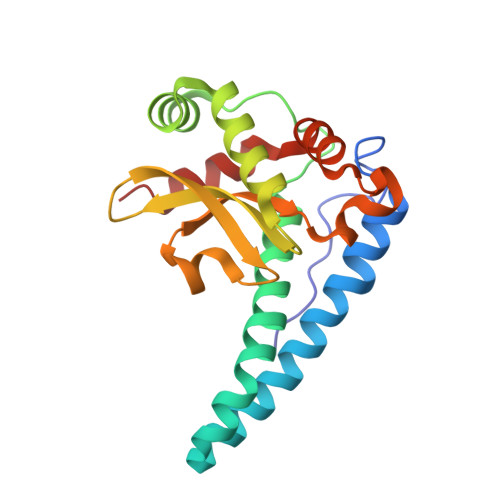Catalytic and structural effects of amino acid substitution at histidine 30 in human manganese superoxide dismutase: insertion of valine C gamma into the substrate access channel
Hearn, A.S., Stroupe, M.E., Cabelli, D.E., Ramilo, C.A., Luba, J.P., Tainer, J.A., Nick, H.S., Silverman, D.N.(2003) Biochemistry 42: 2781-2789
- PubMed: 12627943
- DOI: https://doi.org/10.1021/bi0266481
- Primary Citation of Related Structures:
1LUV, 1LUW - PubMed Abstract:
Catalysis of the disproportionation of superoxide by human manganese superoxide dismutase (MnSOD) is characterized by an initial burst of catalysis followed by a much slower region that is zero order in superoxide and due to a product inhibition by peroxide anion. We have prepared site-specific mutants with replacements at His30, the side chain of which lies along the substrate access channel and is about 5.8 A from the metal. Using pulse radiolysis to generate superoxide, we have determined that kcat/K(m) was decreased and product inhibition increased for H30V MnSOD, both by 1-2 orders of magnitude, compared with wild type, H30N, and H30Q MnSOD. These effects are not attributed to the redox potentials, which are similar for all of these variants. An investigation of the crystal structure of H30V Mn(III)SOD compared with wild type, H30Q, and H30N Mn(III)SOD showed the positions of two gamma carbons of Val30 in the active site; Cgamma1 overlaps Cgamma of His30 in wild type, and Cgamma2 extends into the substrate access channel and occupies the approximate position of a water molecule in the wild type. The data suggest that Cgamma2 of the Val side chain has significantly interrupted catalysis by this overlap into the access channel with possible overlap with the substrate-product binding site. This is supported by comparison of the crystal structure of H30V MnSOD with that of azide bound to Mn(III)SOD from Thermus thermophilus and by visible absorption spectra showing that azide binding to the metal in H30V Mn(III)SOD is abolished. Moreover, the presence of Val30 caused a 100-fold decrease in the rate constant for dissociation of the product-inhibited complex compared with wild type.
Organizational Affiliation:
Department of Pharmacology, University of Florida, Gainesville, Florida 32610-0267, USA.















